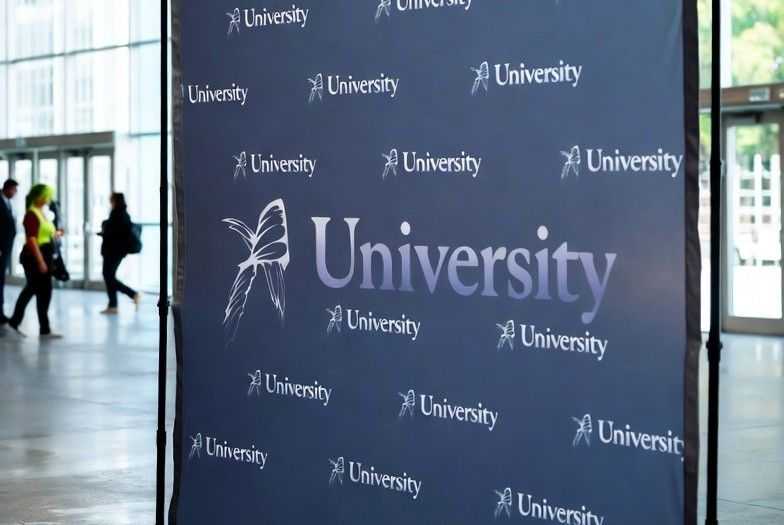
Technology and education events are becoming increasingly visual, using design as a way to communicate innovation and identity. From academic symposiums to international tech summits, one of the most recognizable features is the step and repeat banner. These backdrops not only frame photographs but also shape the visual narrative of the event. They remind attendees of the institutions, companies, and ideas that bring people together for learning and discovery.
Across campuses and tech hubs, the art of backdrop printing NYC has evolved into a thoughtful design process that blends branding with education. Banners are now more than just photo backgrounds; they are interactive storytelling tools. Universities use them during open days, labs display them at tech fairs, and ed-tech startups bring them to international showcases. Each one tells a story of innovation, creativity, and collaboration.
1. The University of Innovation: Clean, Modern, and Readable
At the University of Innovation’s annual research symposium, readability takes center stage. Designers used crisp typography, high-contrast colors, and subtle gradients to ensure that every logo and word could be read from afar. According to one event coordinator, “Our banner had to communicate clarity and professionalism without feeling corporate.” This example shows how simplicity can sometimes be the most powerful design strategy.
2. MIT Tech Week: Data Meets Design
At MIT’s Tech Week, the banner became an interactive learning tool. QR codes were placed within the design, linking to speaker bios, event schedules, and real-time research demos. This blending of physical and digital elements highlights how tech events are experimenting with engagement right on their walls.
3. Stanford AI Summit: Integrating Light and Movement
Stanford’s Artificial Intelligence Summit redefined what a step and repeat banner could be. The event used subtle LED lighting around the perimeter to make sponsor logos glow during photo ops. This clever combination of technology and branding turned the backdrop into a visual experience that reflected the theme of innovation.
4. Columbia University’s Sustainability Fair
Columbia’s Sustainability Fair embraced eco-friendly design principles. Their banners were printed on recycled fabric using water-based inks. The muted green tones and leaf motifs created an atmosphere of environmental responsibility while maintaining brand visibility. It was a perfect match for a sustainability-focused event.
5. Google for Education Summit
Google’s education event showed how large companies blend playfulness with professionalism. Their banner featured vibrant geometric shapes and dynamic fonts, echoing Google’s signature look. A touch of interactivity was added through augmented reality (AR) overlays, allowing attendees to scan logos with their phones to access workshop recordings.
6. NYU Design Lab Showcase
New York University’s Design Lab chose an artistic approach. Their backdrop combined student artwork with sponsor logos, merging creativity and recognition. This collaborative design fostered community pride and allowed each department to see its visual identity reflected in the event.
7. EdTech Asia Forum
At the EdTech Asia Forum, design met mobility. The team opted for modular panels that could be rearranged based on the event’s layout. It was a smart way to reuse materials while maintaining a fresh look at every session. The flexibility also made travel logistics easier for international conferences.
8. Harvard Innovation Labs
Harvard’s Innovation Labs took branding consistency to another level. The banner was color-matched with the institution’s digital graphics, ensuring seamless alignment across social media, brochures, and video live streams. This cohesive strategy helped reinforce brand identity across multiple channels.
9. FutureLearn Global Ed Forum
FutureLearn’s banner focused on inclusivity and accessibility. The layout used high-contrast backgrounds and large fonts to ensure readability for all attendees. Subtle animations from a digital screen integrated behind the banner added movement and vibrancy without overwhelming the viewer. It was a balanced blend of aesthetics and usability.
Design Trends to Watch
Modern step and repeat banners are more than static designs—they are becoming intelligent, interactive platforms. According to insights from Smarter Learning Through Technology, educational spaces are increasingly using digital tools to enhance visual engagement and learning. QR codes now guide guests to live polls or presentation slides, while augmented reality brings 3D visuals to life. Some universities even merge printed graphics with digital projections for immersive event experiences. These advancements demonstrate that banners can educate as much as they can promote.
Conclusion
From simple academic logos to dynamic AR-infused displays, step and repeat banners have evolved alongside technology itself. Whether used by a global company or a small university, these designs create moments of connection and visibility. As institutions continue to experiment with materials and interactivity, the role of backdrop printing in NYC will remain at the heart of event storytelling. The best designs remind us that learning spaces are not just about what is said on stage, but also about the visual stories that surround them.
